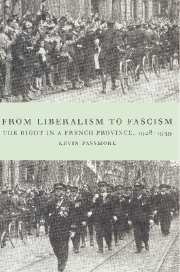Book contents
- Frontmatter
- Contents
- List of illustrations
- Preface
- List of abbreviations
- 1 Introduction
- 2 From France to the Rhône
- 3 Urban society in the Rhône
- 4 Rural society in the Rhône
- 5 The crisis of the right I: 1928–1932
- 6 The impact of the economic crisis
- 7 The crisis of the right II: 1932–June 1936
- 8 The Croix de Feu
- 9 The right and the Popular Front
- 10 Conclusion
- Appendix 1 Equations for multiple regressions
- Appendix 2 The conservative deputies of the Rhône, 1928–1940
- Select bibliography
- Index
3 - Urban society in the Rhône
Published online by Cambridge University Press: 23 December 2009
- Frontmatter
- Contents
- List of illustrations
- Preface
- List of abbreviations
- 1 Introduction
- 2 From France to the Rhône
- 3 Urban society in the Rhône
- 4 Rural society in the Rhône
- 5 The crisis of the right I: 1928–1932
- 6 The impact of the economic crisis
- 7 The crisis of the right II: 1932–June 1936
- 8 The Croix de Feu
- 9 The right and the Popular Front
- 10 Conclusion
- Appendix 1 Equations for multiple regressions
- Appendix 2 The conservative deputies of the Rhône, 1928–1940
- Select bibliography
- Index
Summary
Writers of greater and lesser talent portrayed Lyon as a city of individualism, secrecy, materialism and fear of the envy of others. In the 1920s liberal individualism certainly retained a powerful institutional and cultural position in spite of the relative decline of the silk industry with which it had traditionally been associated. This tradition was represented by Catholic silk manufacturers such as Auguste Isaac and Henry Morel-Journal. The first, like Aynard, had also occupied leading positions in the Fédération républicaine. Mass support for liberal-conservatism had been provided in particular by white-collar workers, who shared liberal ideas about social mobility. The extent to which either elites or conservative masses (let alone those outside the right) were incorporated into a ‘dominant ideology’ should not, however, be exaggerated. The liberal elite defined itself in terms of a set of social, political and religious values which excluded important sections of the dominant classes within Lyon and divided it from some sections of the ruling elites in France as a whole. Neither did electoral support for liberal-conservatism imply unqualified endorsement. Rather support for liberalism depended on favourable market conditions, opportunities for social mobility, the ability of the elites to contain the socialist threat and the tacit support of a Church which was increasingly inclined to turn its long-standing antiliberalism into practical action.
Well before the world economic crisis affected France, liberalconservatism was in difficulties. This crisis must be placed in the context of the national developments outlined in chapter two.
- Type
- Chapter
- Information
- From Liberalism to FascismThe Right in a French Province, 1928–1939, pp. 56 - 89Publisher: Cambridge University PressPrint publication year: 1997

